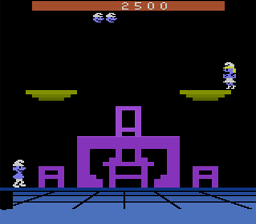If you’ve ever seen the Smurfs television show, you already know way more about the weird little blue things than you really need to to get the full amount of fun out of this game.
Like just about every game I had for my Atari 2600, I didn’t have a manual for this, so I don’t really know what’s going on. All I know is that you, in control of Generic Smurf have to rescue Smurfette. I assume she’s been kidnapped by Gargamel, but he doesn’t make an appearance. All he did was capture her and put her on a shelf over his kitchen table.

It’s not just smooth sailing, though. Gargamel or no, there are still numerous hazards to deal with. Hawks, snakes, spiders, fenceposts, rivers, kitchen chairs, two-inch drops, and more are in your path and every one of them is instantly fatal. But you’re not completely helpless. You have two (yes, two!) kinds of jumps. A feeble hop, and a soaring leap. Your feeble hop doesn’t actually do anything worthwhile, but you can’t do your good jump without doing it first. So every time you come across an obstacle, you have to hop twice to get over it, like you’re on some kind of tiny pogo stick.
This game has six screens filled with anti-smurf everything. None of them are particularly hard to navigate. You just need to jump at the right time to not actually touch anything except the ground (it and air are the only two non-fatal things in this game, walking into a wall kills you). You rescue Smurfette and then have to do it all over again, except with more enemies, and maybe some of the screens will repeat themselves. You’re going to see everything this game has to offer within ten minutes of turning it on.
And the thing is, I used to play this game a lot. A whole lot. It was probably because I was too uncoordinated or to dim to remember that you have to jump twice to actually jump over anything. Once that finally stuck, I sailed through the game about a dozen times in a row without losing a life. And that would be the last time I would ever play this game. My streak has crested 20 years so far.
Here’s to another 20.